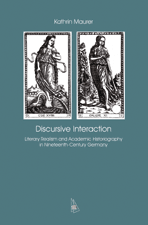
2006, 178 pp., pbk.
€ 29,80
ISBN 978-3-935025-87-4
The question of the relationship between literature and history has a long tradition. The distinction between fiction and fact, invention and document, has provoked controversies since Antiquity. In the course of the professionalization of historiography and the historicizing of literature in nineteenth-century Germany both fields entered into a unique correlation. They are seen as deeply intertwined and as complementary phenomena with structural, functional, and stylistic similarities. Academic historicism and historical realist prose mutually copy, borrow, imitate, and transform modes of representation. Based on theoretical propositions by Roland Barthes, Niklas Luhmann, and New Historicism the book uses a model of interdiscursivity in order to analyze scholarly and non-scholarly historical discourses that show common rhetorical strategies but shape different forms of historical representation. Leopold von Ranke’s, Gustav Droysen’s, and Heinrich Schliemann’s writings make use of realistic writing strategies to legitimize the scholarliness of their texts and, thus, realist literature gains a modeling function in conceptualizing academic writing. Conversely, historical realist fiction is experimenting with scholarly writing strategies. By creatively recycling academic vocabulary, Adalbert Stifter’s, Wilhelm Raabe’s, and Gottfried Keller’s historical prose problematizes the very possibility of representing history in a factually assumed fashion and thus voices alternative views of history.
Kathrin Maurer has a Ph.D. in German literature from Columbia University and is Assistant Professor in German Studies at the University of Arizona.